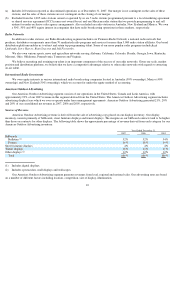iHeartMedia 2007 Annual Report Download - page 19
Download and view the complete annual report
Please find page 19 of the 2007 iHeartMedia annual report below. You can navigate through the pages in the report by either clicking on the pages listed below, or by using the keyword search tool below to find specific information within the annual report.
Regulation of Our Radio and Television Broadcasting Businesses
E
xisting Regulation and 1996 Legislation
Radio and television broadcasting are subject to the jurisdiction of the FCC under the Communications Act of 1934 (the
“Communications Act”). The Communications Act prohibits the operation of a radio or television broadcasting station except under a license
issued by the FCC and empowers the FCC, among other things, to:
The Communications Act prohibits the assignment of a license or the transfer of control of a licensee without prior approval of the FCC.
The 1996 Act represented a comprehensive overhaul of the country’s telecommunications laws. The 1996 Act changed both the process
for renewal of broadcast station licenses and the broadcast ownership rules. The 1996 Act established a “two-step” renewal process that limited
the FCC’s discretion to consider applications filed in competition with an incumbent’s renewal application. The 1996 Act also liberalized the
national broadcast ownership rules, eliminating the national radio limits and easing the national restrictions on TV ownership. The 1996 Act
relaxed local radio ownership restrictions, but left local TV ownership restrictions in place pending further FCC review.
L
icense Grant and Renewal
Under the 1996 Act, the FCC grants broadcast licenses to both radio and television stations for terms of up to eight years. The 1996 Act
requires the FCC to renew a broadcast license if it finds that:
In making its determination, the FCC may consider petitions to deny and informal objections, and may order a hearing if such petitions
or objections raise sufficiently serious issues. The FCC, however, may not consider whether the public interest would be better served by a
person or entity other than the renewal applicant. Instead, under the 1996 Act, competing applications for the incumbent’s spectrum may be
accepted only after the FCC has denied the incumbent’s application for renewal of its license.
Although in the vast majority of cases broadcast licenses are renewed by the FCC, even when petitions to deny or informal objections are
filed, there can be no assurance that any of our stations’ licenses will be renewed at the expiration of their terms.
Current Multiple Ownership Restrictions
The FCC has promulgated rules that, among other things, limit the ability of individuals and entities to own or have an “attributable
interest” in broadcast stations and other specified mass media entities.
The 1996 Act mandated significant revisions to the radio and television ownership rules. With respect to radio licensees, the 1996 Act
directed the FCC to eliminate the national ownership restriction, allowing one entity to own nationally any number of AM or FM broadcast
stations. Other FCC rules mandated by the 1996 Act greatly eased local radio ownership restrictions. The maximum allowable number of radio
stations that may be commonly owned in a market varies depending on the total number of radio stations in that market, as determined using a
method prescribed by the FCC. In markets with 45 or more stations, one company may own, operate or control eight stations, with no more
than five in any one service (AM or FM). In markets with 30-44 stations, one company may own seven stations, with no more than four in any
one service. In markets with 15-29 stations, one entity may own six stations, with no more than four in any one service. In markets with 14
stations or less, one company may own up to five stations or 50% of all of the stations, whichever is less, with no more than three in any one
service. These new rules permit common ownership of more stations in the same market than did the FCC’s prior rules, which at most allowed
ownership of no more than two AM stations and two FM stations even in the largest markets.
18
• issue, renew, revoke and modify broadcasting licenses;
• assign frequency bands;
• determine stations’ frequencies, locations and power;
• regulate the equipment used by stations;
• adopt other regulations to carry out the provisions of the Communications Act;
• impose penalties for violation of such regulations; and
• impose fees for processing applications and other administrative functions.
• the station has served the public interest, convenience and necessity;
• there have been no serious violations of either the Communications Act or the FCC’s rules and regulations by the licensee; an
d
• there have been no other violations which taken together constitute a pattern of abuse.
























